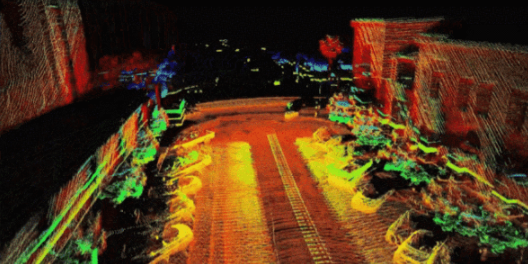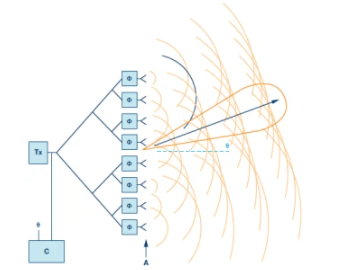According to foreign media futurecar, Quanergy, a lidar startup from Silicon Valley, recently announced the development of a new solid-state lidar called S3, which uses phased array technology and has completed detection tests within a range of 100 meters.
The S3 solid-state lidar launched by Quanergy is the first in the industry to adopt optical phased array technology. It will use a scalable SOI CMOS manufacturing process and will be mass-produced in the future.
The company said that in the future, this technology will not only be used in the autonomous driving systems of cars, but will also be used in more IoT service areas.
1. The first phased array technology was used to complete the 100-meter ranging test
The test was conducted jointly by Quanergy and Zero Electric Vehicle (ZEV), an innovative sustainable energy company from Arizona, USA.
Quanergy chose to conduct the test in the daytime with good lighting conditions. The test vehicle was equipped with a single scanning beam lidar unit and a camera component for observation. During the test, the test vehicle kept following the target vehicle and constantly changed the following distance, with the longest following distance reaching 100 meters.

▲The radar is detecting road conditions
In order to test the performance of the hardware when driving at night and encountering dark-colored vehicles, Quanergy deliberately used objects with a radar reflectivity of only 10% as the detected targets to simulate this situation.
When illuminated by the lidar, light-colored vehicles can reflect more electromagnetic waves than dark-colored vehicles, so it is easier for the lidar to detect light-colored vehicles, and dark-colored vehicles are more difficult to be detected.
The S3 solid-state LiDAR released by Quanergy is the industry's first product using phased array technology. Phased array technology was first used in the military field. This technology generates electromagnetic waves with controllable directions by controlling the signal phase changes of each unit.
Compared with traditional lidar, phased array radar can change the emission direction of electromagnetic waves without rotating the radar itself. It has the characteristics of short response time, large data volume and high reliability.

▲Schematic diagram of the working principle of phased array radar
Quanergy co-founder Tianyue Yu said that this test is the first attempt in the industry, and they are very excited about it. They will continue to work hard to achieve greater goals and hope to increase the detection distance of this radar to 200 meters in the future.
2. The trouble-free time exceeds 100,000 hours and will be mass-produced
Quanergy hopes that the S3 solid-state lidar can not only meet basic functions such as road ranging and object detection, but also has a certain degree of damage resistance, aiming to reduce users' subsequent maintenance costs.
Since the radar uses phased array technology, the body adopts an integrated design. The entire radar is wrapped in a cylinder without any rotatable or movable components. Compared with previous laser radars, this "iron lump" design has higher internal reliability and external damage resistance.

▲The radar design is very simple
After testing by Quanergy, the radar's mean time between failures (MTBF) reached more than 100,000 hours.
MTBF refers to the average continuous failure-free time of a product during operation or testing, and is an industry-recognized indicator for measuring the reliability of electronic products.
In addition, the S3 will adopt SOI CMOS production technology to achieve the goal of low-cost mass production. Currently, Quanergy has priced the radar at US$500 (about RMB 3,200).
According to data from Kaiyuan Securities Research Institute, the average selling price of global LiDAR modules in 2020 is RMB 5,200, which is almost the same as the current price of Quanergy S3. However, don't forget that this is a radar equipped with phased array technology.
Conclusion: LiDAR usage scenarios continue to expand
Quanergy was founded in 2012. Its business mainly involves optics, photonics and artificial intelligence software. But in terms of lidar, Quanergy can be regarded as a rising star. The company is currently preparing to be listed on the New York Stock Exchange through SPAC, and the transaction is expected to be completed in the fourth quarter of this year.
Compared with other competitors in the lidar industry, Quanergy seems to be more ambitious. The company not only wants to get a piece of the hot autonomous driving field, but also aims at the application field of the Internet of Things and wants to show its prowess in this field.
The company has already reached a cooperation with PARIFEX, a French smart city solution provider, to provide software and hardware support for speed measurement and remote enforcement for French highways. In addition, the company has also reached an agreement with companies from China and South Korea to jointly deepen commercial cooperation in the field of the Internet of Things.
Previous article:Navigation app "ALPINE SmartX" supports multiple languages
Next article:2020 "High-Precision Map Solution Market Share" Research Report Officially Released
- Popular Resources
- Popular amplifiers
- Car key in the left hand, liveness detection radar in the right hand, UWB is imperative for cars!
- After a decade of rapid development, domestic CIS has entered the market
- Aegis Dagger Battery + Thor EM-i Super Hybrid, Geely New Energy has thrown out two "king bombs"
- A brief discussion on functional safety - fault, error, and failure
- In the smart car 2.0 cycle, these core industry chains are facing major opportunities!
- The United States and Japan are developing new batteries. CATL faces challenges? How should China's new energy battery industry respond?
- Murata launches high-precision 6-axis inertial sensor for automobiles
- Ford patents pre-charge alarm to help save costs and respond to emergencies
- New real-time microcontroller system from Texas Instruments enables smarter processing in automotive and industrial applications
- Innolux's intelligent steer-by-wire solution makes cars smarter and safer
- 8051 MCU - Parity Check
- How to efficiently balance the sensitivity of tactile sensing interfaces
- What should I do if the servo motor shakes? What causes the servo motor to shake quickly?
- 【Brushless Motor】Analysis of three-phase BLDC motor and sharing of two popular development boards
- Midea Industrial Technology's subsidiaries Clou Electronics and Hekang New Energy jointly appeared at the Munich Battery Energy Storage Exhibition and Solar Energy Exhibition
- Guoxin Sichen | Application of ferroelectric memory PB85RS2MC in power battery management, with a capacity of 2M
- Analysis of common faults of frequency converter
- In a head-on competition with Qualcomm, what kind of cockpit products has Intel come up with?
- Dalian Rongke's all-vanadium liquid flow battery energy storage equipment industrialization project has entered the sprint stage before production
- Allegro MicroSystems Introduces Advanced Magnetic and Inductive Position Sensing Solutions at Electronica 2024
- Car key in the left hand, liveness detection radar in the right hand, UWB is imperative for cars!
- After a decade of rapid development, domestic CIS has entered the market
- Aegis Dagger Battery + Thor EM-i Super Hybrid, Geely New Energy has thrown out two "king bombs"
- A brief discussion on functional safety - fault, error, and failure
- In the smart car 2.0 cycle, these core industry chains are facing major opportunities!
- The United States and Japan are developing new batteries. CATL faces challenges? How should China's new energy battery industry respond?
- Murata launches high-precision 6-axis inertial sensor for automobiles
- Ford patents pre-charge alarm to help save costs and respond to emergencies
- New real-time microcontroller system from Texas Instruments enables smarter processing in automotive and industrial applications
- Micrometer based on TI MSP430 microcontroller
- What is eSIM? What are the key advantages of eSIM for IoT? Truphone experts will answer your questions for free!
- The east-west direction of the compass is reversed
- Looking for a serial port assistant that can send commands alternately and supports 2400 baud rate
- Registration for the first half of 2019 software exam is now open
- MSP430 G2553 Low Power Mode LPMx
- OP-07 read voltage
- How to set individual trace solder mask windows in DXP?
- [Jihai APM32E103VET6S MINI development board review] GPIO flip test
- Hardcore disassembly | See how the thousand-yuan smart meter is connected internally! 50-yuan Jingdong card is waiting for you

 MC33204VDTB
MC33204VDTB











 京公网安备 11010802033920号
京公网安备 11010802033920号